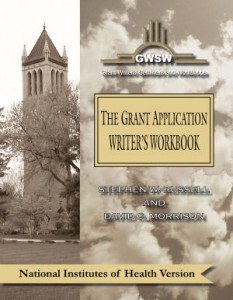Are you concerned about writing your next NIH grant application? If not, you probably should be, largely because of the major changes that NIH has recently implemented in how proposals are written and reviewed. Unfortunately the magnitude of these changes does not seem to be fully appreciated by the greater NIH extramural community. Thus, more than a few applicants are likely to be in for a rather rude awakening when they write their next grant proposal.
In the applications on which we have consulted since the changes were made, the one key issue that appears to be giving applicants the most trouble is discussion of the scientific premise of the proposed research (scientific foundation). Two key elements support your application’s scientific premise: (1) the reliability of the published literature that you cite; and (2) the degree of dependability of your own preliminary results. NIH now requires that the strengths and weakness of these two ‘legs’ of Scientific Premise be discussed. To make your case most persuasively, such discussion must be presented as a seamless continuum of the collection of published and preliminary results that underpin your proposal. Do you really know how to do that?
Writing the application is not all that is of importance! As noted above, there have also been important changes in how NIH Study Section members are instructed to review applications. For example, there are three new questions that reviewers will ask in areas of emphasis that will affect your overall impact score, either positively or negatively. They are: 1) scientific premise of the proposed research (“Is there a strong scientific premise for the project?”); 2) rigorous experimental design (“Have the investigators presented strategies to ensure a robust and unbiased approach?”); and 3) consideration of relevant biological variables (“Have the investigators presented adequate plans to address relevant biological variables, such as sex, for studies in vertebrate animals or human subjects?“). (Quoted questions come from the newly expanded review criteria, which can be reviewed on the NIH website here. Do you really know how to strategically answer these new questions?
Ostensibly, NIH has provided new instructions that are reported to be “simplified and made easier” (see http://grants.nih.gov/grants/how-to-apply-application-guide.htm), compared to the instructions that they have replaced. Your reaction to these new instructions may well be the same as ours: they are going to take a lot of getting used to! While it is true that the new format, in some respects, makes it easier to understand (each requirement is listed as a separate bullet, rather than as part of a narrative), there is extensive use of hyperlinks which direct the reader from the published instructions to multiple parts of the NIH website. This means that, to understand how to write your application, you would be required to frequently abandon the online instructions in order to acquire that additional information. In other words, there is no single, hard copy document that contains all of the instructions – unless you would be willing to print all of the web-related information that complements and extends the newly published Research Instructions for NIH and Other PHS Agencies. Would you rather have a one-stop way to avoid such additional work?
If the answer to the above question would be in the affirmative, the extensively updated April 2016 Edition of The Grant Application Writer’s Workbook – NIH Version would be a good investment. This edition, which is available today, May 2, 2016, has been extensively modified to provide you with the necessary insights needed to cope with NIH’s paradigm-shifting changes. It will help you by:
• demystifying the concept of, and the strategies for, presenting the underlying scientific premise of your proposal;
• pointing out how to discuss strengths and weaknesses, as well as the strategic use of literature review and preliminary results;
• helping you to increase the scientific rigor of proposed experimental protocols and the authentication of key biological and/or chemical resources; and
• guiding your use of the new PHS Assignment Request Form to your advantage.
If you think that you would have a potential interest in a copy of our new edition, we would invite you to review several representative sample pages on our NIH Workbook page. Given the number of pre-orders we have received already, we would encourage you to place your order soon, while copies of the first printing are still available.

